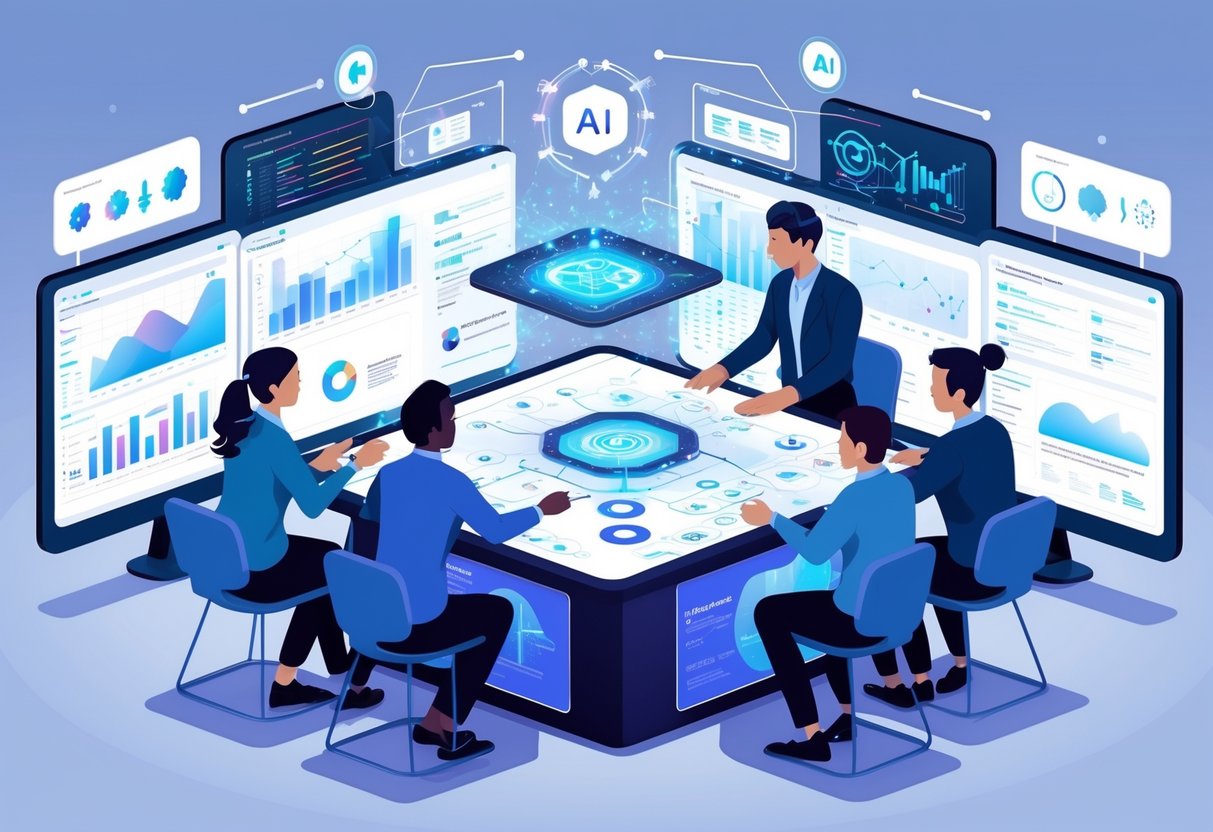Analytics engineers today face growing pressure to integrate artificial intelligence into their workflows as data volumes explode and business demands for faster insights increase. AI tools can automate routine tasks, enhance data quality, and unlock predictive capabilities that transform how analytics engineers build and maintain data pipelines.
These technologies range from automated data cleaning platforms to machine learning frameworks that require minimal coding experience.

The landscape of AI tools for data analysis has evolved rapidly, offering analytics engineers practical solutions for common challenges like data transformation, anomaly detection, and performance optimization.
Modern AI platforms can generate code, suggest optimizations, and even predict potential pipeline failures before they occur.
Understanding which tools to use and when to implement them becomes crucial for staying competitive in this field.
Key Takeaways
- AI tools help analytics engineers automate repetitive tasks and improve data pipeline efficiency
- Popular AI technologies include machine learning frameworks, automated testing tools, and predictive analytics platforms
- Successful implementation requires understanding both technical capabilities and practical business applications
Core Concepts of AI Tools in Analytics Engineering

AI tools transform how analytics engineers process data and build systems by automating complex tasks and providing intelligent insights.
These technologies integrate seamlessly with existing workflows while delivering faster, more accurate results for data-driven decision making.
Defining AI and Analytics for Engineers
AI tools in analytics engineering combine machine learning algorithms with data processing capabilities to automate analytical tasks.
These systems can identify patterns, predict outcomes, and optimize data workflows without manual intervention.
Key AI technologies include:
- Machine learning models for pattern recognition
- Natural language processing for data queries
- Automated feature engineering
- Predictive analytics algorithms
Analytics engineers use these tools to build data pipelines that learn and adapt.
The AI components can automatically detect data quality issues, suggest optimizations, and flag anomalies in real-time.
Unlike traditional analytics, AI-driven analytics systems can process unstructured data from multiple sources.
They handle text, images, and complex datasets that would require extensive manual coding.
The artificial intelligence layer adds intelligence to standard ETL processes.
It can recommend the best data transformations and predict which models will perform well on specific datasets.
How AI Tools Integrate with Analytics Workflows
AI tools connect directly to existing data infrastructure through APIs and cloud platforms.
They work alongside traditional analytics tools like SQL databases, data warehouses, and visualization software.
Integration happens at multiple workflow stages:
- Data ingestion: AI automatically validates and cleans incoming data
- Processing: Machine learning optimizes query performance and resource allocation
- Analysis: Automated model selection and hyperparameter tuning
- Reporting: Natural language generation creates insights summaries
Cloud services like AWS, GCP, and Azure provide pre-built AI services that integrate with analytics pipelines.
Engineers can add machine learning capabilities without building models from scratch.
The integration requires minimal code changes to existing workflows.
Most AI tools offer drag-and-drop interfaces or simple configuration files for setup.
Analytics engineers can maintain their current tools while adding AI capabilities.
The artificial intelligence components run in parallel, enhancing rather than replacing existing processes.
Benefits of AI-Driven Analytics
AI tools deliver significant performance improvements and cost savings for analytics engineering teams.
They reduce manual work while increasing the accuracy and speed of data processing.
Primary benefits include:
- Faster processing: Automated data preparation cuts development time by 60-80%
- Better accuracy: Machine learning models detect patterns humans miss
- Cost reduction: Less manual coding and maintenance required
- Scalability: AI systems handle growing data volumes automatically
Teams can focus on strategy and business logic instead of repetitive coding tasks.
The AI handles routine data cleaning, validation, and transformation work.
Data-driven decisions become more reliable with AI assistance.
The tools can identify bias in datasets and suggest corrections before analysis begins.
Real-time insights become possible with AI-powered streaming analytics.
These systems process data as it arrives and alert teams to important changes immediately.
Key AI Technologies and Tools for Analytics Engineers

Analytics engineers need specific programming languages like Python and SQL, along with machine learning frameworks and AI-powered business intelligence tools.
Natural language processing capabilities are transforming how engineers interact with data and automate routine tasks.
Programming Languages and Environments
Python dominates the analytics engineering landscape due to its extensive libraries and ease of use.
Engineers use Python for data manipulation, statistical analysis, and building machine learning pipelines.
SQL remains essential for database operations and data querying.
Modern SQL variants support advanced analytics functions and can integrate with machine learning workflows directly within database environments.
R provides specialized statistical computing capabilities.
Many analytics engineers use R for complex statistical modeling and data visualization tasks.
Cloud-based environments like Google Colab and Jupyter notebooks offer collaborative spaces for development.
These platforms support multiple programming languages and provide built-in access to computing resources.
Machine Learning Libraries and Deep Learning
Scikit-learn serves as the foundation for machine learning algorithms in Python.
It includes classification, regression, clustering, and dimensionality reduction tools that analytics engineers use daily.
TensorFlow and PyTorch power deep learning applications.
These frameworks enable engineers to build neural networks for complex pattern recognition and predictive modeling tasks.
Pandas handles data manipulation and analysis.
Engineers rely on pandas for cleaning, transforming, and preparing datasets before applying machine learning algorithms.
The LangChain framework helps developers build smart apps by connecting large language models with external data sources and APIs.
This tool supports document memory and task chaining for complex workflows.
AI-Powered BI Tools and IDEs
Modern business intelligence tools integrate AI capabilities for automated insights and predictive analytics.
These platforms can identify patterns and generate reports without manual intervention.
Power BI and Tableau now include machine learning features.
Engineers can build predictive models directly within these visualization platforms.
Google Analytics Intelligence uses natural language queries to generate insights.
Users can ask questions in plain English and receive data-driven answers automatically.
AI-enhanced IDEs like GitHub Copilot assist with code generation and debugging.
These tools can suggest code completions and identify potential errors in real-time.
Amazon SageMaker provides a cloud-based machine learning platform with pre-built algorithms and one-click deployment capabilities.
It supports both beginners and advanced users through managed Jupyter notebooks.
Natural Language Processing and Automation
Natural language processing tools enable analytics engineers to extract insights from unstructured text data.
These capabilities include sentiment analysis, entity extraction, and document summarization.
Automated reporting systems generate insights from data using natural language generation.
Engineers can set up these systems to produce regular reports without manual writing.
Chatbot integration allows stakeholders to query data using conversational interfaces.
Analytics engineers build these systems to democratize data access across organizations.
Text preprocessing libraries like NLTK and spaCy handle tokenization, stemming, and named entity recognition.
These tools prepare text data for analysis and machine learning applications.
Voice-to-query systems convert spoken questions into database queries.
This technology reduces the technical barrier for non-technical users accessing analytics insights.
Applications and Best Practices of AI Tools in Analytics Engineering

AI tools transform how analytics engineers approach data processing, prediction, and maintenance tasks.
These applications span from automated anomaly detection to advanced machine learning model deployment and real-time data pipeline optimization.
Predictive Analytics and Maintenance
Analytics engineers use AI tools to build predictive analytics systems that detect patterns before problems occur.
Machine learning models analyze historical data to forecast equipment failures, user behavior, and system performance issues.
Key predictive maintenance applications:
- Server downtime prediction using log analysis
- Database performance monitoring with automated alerts
- Data pipeline failure detection through pattern recognition
Engineers implement these systems using tools like Apache Airflow for orchestration and MLflow for model management.
The models continuously learn from new data to improve accuracy over time.
Predictive maintenance reduces costly system outages by 30-50% in most organizations.
Engineers set up automated alerts that trigger before critical thresholds are reached.
The process involves collecting metrics, training models on historical failure data, and deploying real-time monitoring systems.
Engineers must balance sensitivity to avoid false alarms while catching genuine issues early.
Enhancing Analytics Capabilities with AI
AI amplifies traditional analytics by automating insight generation and pattern discovery.
Natural language processing tools allow business users to query data using plain English instead of complex SQL statements.
Core AI enhancements include:
- Automated anomaly detection in data streams
- Smart data profiling and quality assessment
- Intelligent feature engineering for machine learning models
- Natural language query interfaces
Analytics engineers integrate these capabilities using cloud platforms like AWS SageMaker or Google AutoML.
The tools automatically generate insights that would take hours to discover manually.
AI-powered analytics tools help engineers identify data quality issues before they impact downstream systems.
Machine learning algorithms flag unusual patterns, missing values, and data drift in real-time.
Engineers also use AI for automated report generation.
The systems create summaries, highlight key trends, and suggest actionable recommendations based on data analysis.
Implementing Data Science Solutions
Data science integration requires analytics engineers to bridge traditional data pipelines with machine learning workflows.
This involves creating systems that support model training, deployment, and monitoring at scale.
Essential implementation components:
- Feature stores for consistent data access across teams
- Model versioning and experiment tracking systems
- Real-time inference pipelines for production models
- Data drift monitoring and model retraining automation
Engineers use tools like dbt for data transformation and Apache Kafka for streaming data to ML models.
The architecture must handle both batch and real-time processing requirements.
Successful implementations require close collaboration between analytics engineers and data scientists.
Engineers focus on data infrastructure while scientists develop and tune models.
Monitoring requirements:
- Model performance tracking
- Data quality validation
- Pipeline health monitoring
- Resource usage optimization
Engineers set up automated retraining pipelines that update models when performance degrades or new data becomes available.
This ensures models remain accurate as business conditions change.
Frequently Asked Questions

Analytics engineers need specific technical skills and understanding of how AI tools work with existing data workflows.
The integration process involves connecting machine learning capabilities with traditional analysis methods while requiring knowledge of programming languages and prompt engineering techniques.
What are the core skills needed to become proficient in AI-powered data analytics?
Analytics engineers need strong foundations in statistics and mathematics to understand how AI algorithms process data.
SQL remains essential for database management and data extraction tasks.
Python and R programming skills allow engineers to work with machine learning libraries and data manipulation tools.
Understanding data visualization helps communicate AI-generated insights to stakeholders.
Machine learning concepts like supervised and unsupervised learning help engineers choose the right AI approaches.
Knowledge of data cleaning and preparation ensures quality inputs for AI models.
How do AI tools integrate with traditional data analysis methods?
AI tools enhance existing workflows by automating repetitive data processing tasks.
Traditional SQL queries can feed data into machine learning models for advanced pattern recognition.
AI algorithms can process large datasets quickly while maintaining accuracy that human analysts might miss.
The combination allows analysts to focus on strategic interpretation rather than manual calculations.
Many AI platforms connect directly to existing databases and business intelligence tools.
This integration preserves current data infrastructure while adding predictive capabilities.
What are the advantages of using AI in data analysis over conventional techniques?
AI improves accuracy since algorithms can process large datasets without human error.
Speed increases dramatically when handling millions of data points compared to manual analysis.
Pattern detection capabilities surpass human recognition for complex relationships in data.
AI models can identify trends across multiple variables simultaneously.
Scalability allows organizations to analyze growing data volumes without proportional increases in staff.
Consistency in analysis methods eliminates variations between different human analysts.
Can you recommend any comprehensive courses that cover AI fundamentals for analytics engineering?
Machine learning courses from platforms like Coursera and edX provide foundational knowledge in algorithms and model development.
Stanford’s CS229 course offers deep technical understanding of machine learning mathematics.
Data science bootcamps combine practical AI skills with analytics engineering workflows.
University programs in data science or computer science include AI coursework with hands-on projects.
Cloud platform certifications from AWS, Google Cloud, or Azure cover AI services specific to data analytics.
These programs focus on implementing AI tools in production environments.
What programming languages are essential for engineers working with AI in data analysis?
Python dominates AI development with libraries like pandas, scikit-learn, and TensorFlow for data manipulation and machine learning.
R excels in statistical analysis and offers specialized packages for advanced analytics.
SQL remains crucial for data extraction and database management in AI workflows.
JavaScript helps build interactive dashboards and web-based analytics applications.
Java and Scala support big data processing frameworks like Spark for large-scale AI implementations.
These languages handle distributed computing requirements in enterprise environments.
In the context of analytics engineering, how does prompt engineering improve data analysis outputs?
Prompt engineering helps analytics engineers communicate clearly with AI language models to generate accurate code and analysis.
Well-crafted prompts produce more relevant SQL queries and data interpretations.
Specific prompts guide AI tools to focus on particular metrics or business questions.
This targeting reduces irrelevant outputs and improves analysis quality.
Clear instructions help AI tools understand data context and business requirements.

